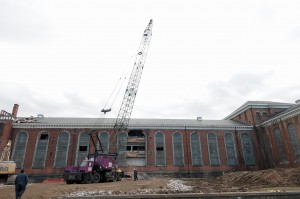Crane Begins to Dismantle MD House of Correction
TOWSON, MD —A landmark deconstruction event began in earnest today, when the contractor working with inmates to take down the Maryland House of Correction began using heavy equipment to remove large chunks of the building. The 45-ton crane arrived on the work site in three trucks and was assembled on site. Media were invited out to record the crane’s first work, and what will likely be the public’s last glimpse of the historic prison in its intact state.
Begun by former DPSCS Secretary Gary Maynard—who returned to witness today’s historic moment— the House of Correction deconstruction is the most unique and largest inmate labor project in America. More than 120 inmates have been trained in hazardous materials abatement and other skills, as inmates themselves help to deconstruct the prison, which opened its doors in 1879 and closed after a spate of fatal violence in 2007.
While it was Maynard’s vision that led to this project, it was made possible through a collaboration of multiple state agencies, foundations and the building trades. A $150,000 grant from the Abell Foundation paid for the inmate training. The Department of Labor Licensing and Regulation developed the curriculum and brought together the building trades needed to help with the pre-apprenticeship certification inmate completing the program receive.
The House deconstruction is the single largest Public Safety Works (PSW) effort ever undertaken by DPSCS. PSW is the Department’s signature inmate restorative justice program, which features three to four hundred inmates on any given day performing meaningful (and often skilled labor) jobs to pay society back. These have included the restoration of historic cemeteries and battlefields, the “planting” of tens of millions of oyster spat and trees, the construction of handicap-accessible curbs, and the rebuilding of flooded and storm-damaged towns, playgrounds, and parks.
“This moment is the culmination of a tremendous effort,” said DPSCS Secretary Gregg Hershberger. ‘‘Nowhere else in America are inmates involved in so meaningful a project.”
Added former Secretary Gary Maynard, whose idea led to the deconstruction: “Maryland is a leader in many correctional areas, and this project shows what can be done when good people work together in an effort to save taxpayers and teach inmates at the same time. I want to thank our partners at DLLR, the Abell Foundation and the MD Historic Trust for making all of this happen.”
Closed by Governor Martin O’Malley and Secretary Maynard in March of 2007 after the murder of Correctional Officer David McGuinn and several other fatal and near-fatal incidents of violence, the House of Correction was one of the nation’s oldest maximum-security prisons still in use. Its 28-inch-thick walls, narrow catwalks, and long, multi-tiered wings were unique in all of America—but the antiquated design contributed to the violence.
Deconstructing—rather than outright demolishing— the building is saving taxpayers an estimated five million dollars. An additional benefit is that DPSCS has been able to recycle more than a quarter million dollars’ worth of doors, windows, fencing, and other items for use by other correctional facilities. And the contractor, CAM Construction, has been able to salvage many tons of additional steel, copper, and other materials. In all, deconstruction will allow approximately 90% of the wreckage from the old prison to stay out of landfills.
But perhaps the biggest benefit is the training inmates are receiving. Working with professional tradesmen, the inmates are becoming certified in hazardous materials abatement and other skills, which will potentially give them a leg up on good-paying jobs when they return to society. The contractors have been pleased with the work ethic of the inmates, who have had a hand in nearly every major aspect of the deconstruction process, totaling more than 51 thousand work hours. Presently, 67 inmates are active.
Once the House is fully deconstructed, an additional 40 to 50 inmates will be responsible for cleaning, palletizing, and shrink-wrapping the estimated 100-thousand bricks that will be saved for use by DPSCS on future community projects.
CAM Construction is overseeing the deconstruction process with the heavy equipment. More importantly, CAM agreed to use inmate labor and provide real-world, marketable, on the job training, a great benefit to offenders going through the program and soon to be released. Berg Group is a subcontractor for some services. The removal of large sections of the prison will continue for the next few months.
Governor Martin O’Malley, who authorized the closure of the prison in 2007, calls the deconstruction proof of Maryland’s commitment to the public’s safety. “The demolition of what was once one of America’s most violent prisons symbolizes Maryland’s commitment to a safer correctional system,” said Governor O’Malley. “Secretary Maynard’s vision and leadership of this process has resulted in millions of dollars in savings for the State and helped drive down our recidivism rate by double-digits.”

